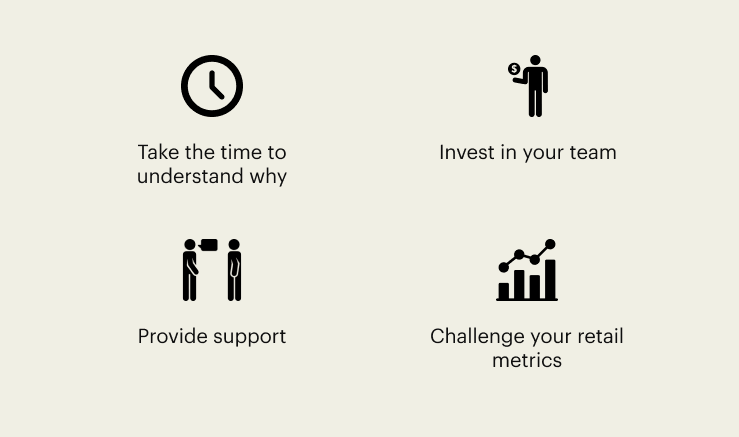Qvalon Blog article content
Written By: Jul Domingo
Do you ever feel frustrated when your goals remain elusive despite your best efforts?
That’s fairly normal.
Experts suggest monitoring your progress can significantly influence the outcome of your efforts.
Based on a meta-analysis of 138 studies comprising 19,951 participants, those who physically record reports of their progress had a better chance of meeting their goals. Additionally, monitoring more frequently has increased the chances of success.

The same is true for retailers and business owners.
Defining retail metrics can be an absolute game-changer, whether tracking business goals or overcoming retail challenges.
But it’s not a one-time thing.
To avoid KPI challenges down the road, you need to make sure you keep revisiting and updating your retail metrics often.
In this blog post, we’ll discuss why your retail metrics do poorly and how to improve KPI in retail.
Why are retail metrics important?
Famous British mathematician Lord Kelvin stated about KPIs: “When you can measure what you are speaking about, and express it in numbers, you know something about it, when you cannot express it in numbers, your knowledge is of meager and unsatisfactory kind”.
Monitoring your business closely will help you take corrective action when necessary. For example, if there’s a deviation from your end goal, KPIs will help you identify which team or department needs your attention.
To put the importance of KPIs in context:
Imagine your goal is to increase your annual sales by 60%. The strategy you come up with, including defining employee roles, should align with that goal.
To hit the target, your staff must meet their respective objectives. But how do you make sure they do that?
Rather than checking their actions individually, you can establish retail metrics to ensure the whole team is on track.
Doing so will give you an accurate measure of their performance.
However, if your KPIs aren’t properly defined, you’ll likely encounter problems. Because the truth is, expectations can differ from reality - and you’ll discover this only after your new strategy has kicked in.
Why retail metrics don’t work
Retail KPI challenges can affect your employees and your bottom line, so you need to pay attention to them.
If you’re curious why retail metrics don’t work, these are some of the most probable causes:
Unrealistic or unclear KPI goals
Too many KPIs can weaken the focus of your goals.
Let’s say your car dealership company sets a wildly ambitious sales objective. The good news is that top-performing branches will be rewarded with perks at the end of every quarter.
And yet, when you told your staff about this, they appeared less than thrilled. That’s often a sign that you’re setting an unrealistic target.
Moreover, if you pair that with vague KPIs, it’s a recipe for disaster.
Here’s most likely one of the unintended, undesirable implications: There’s likely to be competition among branches - with one branch chasing customers from another. And while one branch may hit the target, you still fall short of your overall sales goal.
Due to vague and unrealistic KPIs, you lose focus on the main objective of increasing sales. Establishing a benchmark with specific conditions is a quick way to solve this problem.
Ineffective communication
KPI challenges in retail often arise from a lack of organizational structure. To solve that, you will have to break down your goals and make sure they’re SMART—Specific, Measurable, Attainable, Realistic, and Timebound.
Unless your teams know what they have to achieve and why they need to achieve it, your project or strategy could spiral out of control. It’s like pointing them to the finish line without explaining which path to take and why.
Lack of accountability is also related to ineffective communication. However, as mentioned earlier, it’s your staff who will carry out the plan, and their KPIs will depend on their role.
That being said, each KPI has a designated owner who manages and achieves its target.
Without a clear understanding of their KPIs, meeting them will become difficult, affecting the entire project. This is why you need to make sure your staff understands their responsibilities.
Lack of action plan
Measuring performance in different departments or teams shows how you have a sense of the ideal. However, without a clear action plan, you won’t be able to navigate and prepare for whatever fundamental step to take next when retail challenges arise.
So when you set your retail metrics, make sure you have the action plan to back it up. Think of your retail metrics as an architectural blueprint and your action plan as the wood and bricks.
Action plans lead to tangible results. Retail metrics, however, provide a benchmark to measure if your steps are in the right direction. You need both to overcome your retail challenges.
Unmeasurable goals
This has to be one of the most common root causes of retail KPI challenges. Your retail metrics serve as a reference point, making it necessary to base them on data.
Otherwise, your KPIs will only serve as abstractions that are difficult to measure.
For instance, you want to increase number of your brick-and-mortar customers compared to your online shop, but most of your marketing relies on social media ads.
Now, this is, of course, not an impossible feat. With the right strategy, it can happen. But, how would you measure it? And if you can’t measure it, how can you come up with a clear-cut set of KPIs?
Optimizing your retail metrics
From serving consumers to stocking saleable goods, you need to ensure that your retail metrics are adequate, relevant, and valuable. Here are four ways to establish and implement metrics and avoid retail challenges:

Take the time to understand why
It’s not enough to set retail KPIs based on gut instinct. Instead, your KPI should reflect the overall strategy.
Let’s look at the most common goal retailers have: Reduce the costs and increase the revenue.
Ask yourself, why do you need it? Of course, all companies want to be profitable, but you need to give more specific answers than that… because only then will the “why” reveal the “how”.
To continue our example above, these strategic tasks could be:
- minimize non-value adding expenses
- streamline your operation to avoid unnecessary outsourcing
- reduce inventory shrinkage (lost and damage inventories)
- implement a price increase, and
- explore untapped markets to increase sales volume
The metrics you need to implement should be dependent on these mini-goals you’ve set. If your why is too broad and generic, it’s going to be harder to strategize. So dig deep to discover the right retail metrics you need to set.
Invest in your team
Your ‘why’ should be your staff’s ‘why’ too. But it won’t happen just because you said so.
If your employees see retail metrics as their end game, the plan won’t be as fruitful as possible.
Retail metrics should be the driving force towards the company’s goals, not the employees’ individual goals. But if the team doesn’t have a clear outcome and directive, the lines get blurred quickly. They might hit monthly quotas and figures, but it won’t be sustainable.
Communicate with your team. Understanding their struggles will ground your KPIs. One smart way of doing this is to perform surveys regularly.
For instance, if you want to increase sales in a particular branch or product category, talking with your staff allows you to determine the best ratio of customers to employees and the ideal sales per employee.
You should also make sure the team understands the point of the goal and how it will benefit them. For example, provide training, run friendly workplace competitions, and provide rewards to remove the pressure of meeting KPIs.
Provide support
When setting goals, you can’t just assign tasks to your employees and expect them to figure things out on their own. In the absence of good communication, you’ll face problems.
It’s important to work with them closely when measuring their performance and create a collaborative environment.
When defining specific objectives, discuss with them what key areas and actions they can take. Then, you can deconstruct these things at a granular level.
If the new strategy is to address underperformance, you can present them with data points proven by analytics. This can help them understand the underlying cause and even develop strategies that can help turn things around.
Another way you can do this is to set up a system that automatically sends staff reminders of their pending or overdue tasks. In addition to being beneficial to each member of your team, this will also prevent delays that could cost your business.
Last but not least, make sure you always provide feedback, both positive and negative. 69% of employees say they would work harder if they felt appreciated, while 92% of respondents agreed that negative feedback has great potential to improve performance if delivered properly.
Challenge your retail metrics
Stale retail metrics are worse than having KPIs. After you have established habits and your people are able to accomplish their tasks continuously, you can now try to experiment and innovate for improvements.
It’s part of growing and scaling. Once your physical store achieves a better customer experience, you might want to explore retail metrics that will boost online engagement to increase your market base.
You should also look into innovating strategies for customer retention like new offers, discounted bundles, exclusive packages, and loyalty programs.
Of course, these goals and tasks come with a new set of retail metrics.
It’s time to overcome your retail KPI challenges
Most businesses suffer from retail KPI challenges because they’re either ill-defined or overly ambitious. This may also result from poor communication with your staff and a lack of an action plan.
However, you can properly establish reliable retail metrics and overcome retail challenges through proper communication and a supportive environment that encourages growth.
QVALON is a retail management system built to help your team set realistic KPIs and achieve them. With our analytics and collaboration tools, it’s easy to spot the trouble areas in your operations, ensure your staff is right on track with their deliverables and tasks, and provide feedback.



